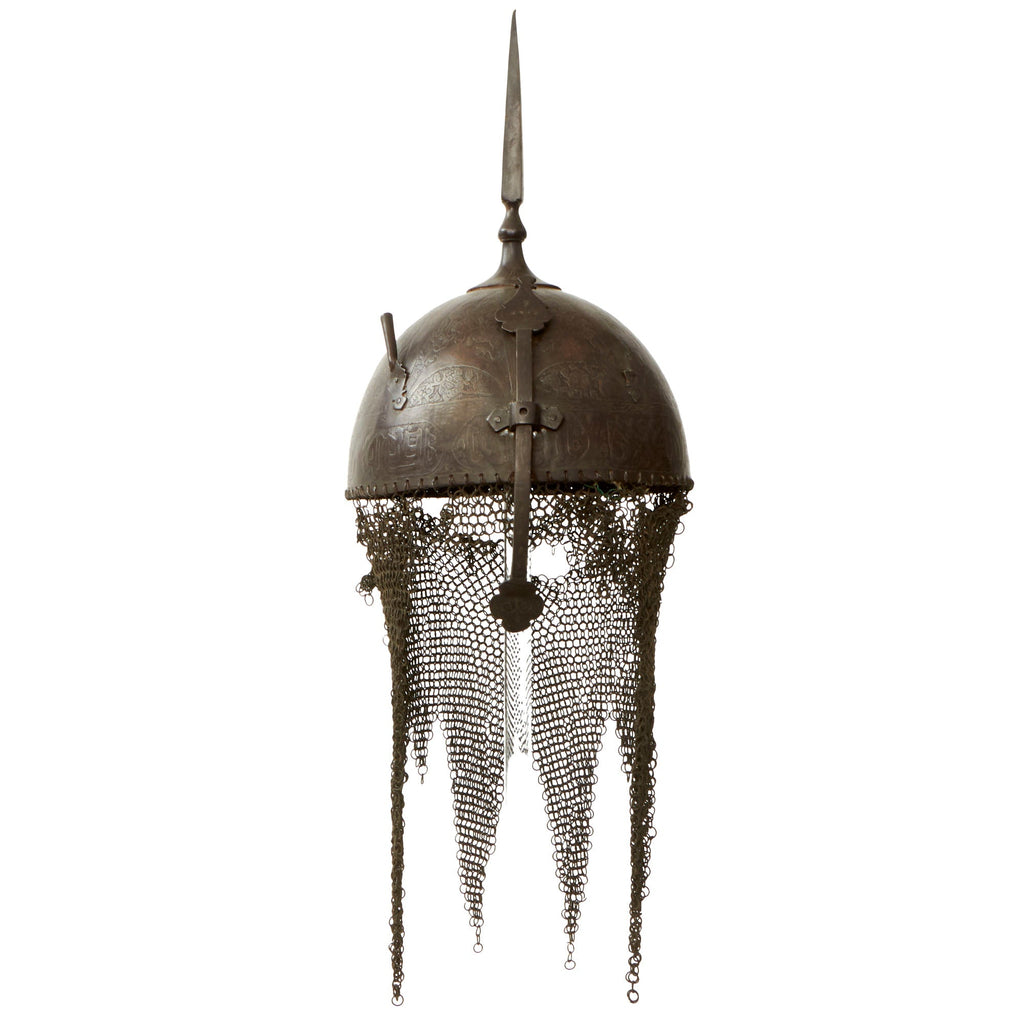Item Description
Original Item: Only One Available. We've all seen the Indo-Persian KULAH KHUD spiked helmets of the 18th and 19th centuries. This design goes back to the times of the Crusaders and Saladin during the battles over the Holy Land in the 12th century. See the Movie KINGDOM OF HEAVEN made by RIDLEY SCOTT for some great examples, as well as a great movie.
Our example here most likely comes from the Northern region of India, and is definitely highly decorated. The main body is made from etched and chiseled steel covered in foliate / floral designs, and looks to have etched writing around the entire bottom, which we unfortunately are not able to read. These are much of the other designs are highlighted with intricate gold inlay, which is somewhat faded in many areas.
The front of the helmet has a sliding nose guard, which does move a bit but is currently stuck in its slot, which is missing the securing nut to keep it from moving, no longer needed. These normally have two feather plume holders flanking the nose guard, however the left side holder has broken off. It also comes with a pointy detachable 4 3/4" spike on the top, which shows worn inlay work as well. The rear of the helmet has the usual "aventail" chain mail rear neck defense, which is still well retained, though many of the loops have come undone from the bottom of the helmet. This could be left as is, or easily remedied with some wire and patience. The helmet is not lined, and we believe was intended to be worn over the typical head dress of the time.
In lovely patinated condition this was recently acquired from a large collection where it had been for decades. Most likely this was originally the war trophy of some Officers who took part in Queen Victoria's Colonial Campaigns.
Ready to display!
NOTE: The clear Plastic Stand is for photography only and is not included.
History of the Kulah Khud Helmet:
Kulah Khuds (known as top in India and Devil mask among English speaking arms collectors) were used in ancient western Asia for battle and as decorative head pieces. This style of helmet originated in Central Asia, and were worn by [Persian Empire] soldiers in the 18th and 19th Centuries. Made of steel, these bowl-shaped helmets were designed as either low and flat, or high and pointed. They sometimes contained a spike socket at the top of the helmet, which resembles a spearhead with a cross-like section. Two or three plume holders were attached on either side of the skull, used to mount feathers from birds such as the egret.
The helmet had an iron-and-brass or brass-and-copper male aventail that hung at the base of the helmet to protect the neck, shoulders and the temple of the face. Sometimes, the male aventail extended down to cover the eyes and the nose. The low end of the male aventail was often shaped in a triangular pattern so they stood relatively affixed on the front and back side of the warrior's shoulder.
A bar made of iron or steel was attached to the front of the helmet with a bracket and could be adjusted in position - so when not in use, it could slide upward and fasten with a link, a hook, or a set screw. The two ends of the bar expanded into leaf-shaped plates, forming a final. In some Indian tops, the lower end of the bar was designed as a large crescent-shaped metal guard that protected most of the face below the eye level. One rare version of the helmet included three irons protecting the nose and the cheeks
- This product is available for international shipping.
- Eligible for all payments - Visa, Mastercard, Discover, AMEX, Paypal & Sezzle












